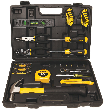Have you ever noticed that bathroom sinks seem to get clogged an awful lot? There is a simple reason for this—as we go through our daily cleaning ritual our hair falls out during the brushing and combing that we put it through. This hair will mix with other hair, and with the shampoo and soap that we use, creating a really nasty "fur ball" that is hard to get rid of. One way to get rid of it, however, is by using a chemical cleaner.
Remember, before using any chemical cleaner, be sure that you fully read the instructions and only use the cleaner as instructed. Chemical cleaners are a highly caustic material that can easily cause chemical burns and other forms of damage to your body. Also, be sure that you do not use something that is too strong for your specific pipes, or that you try using a plunger after pouring the material into the sink, as this could also lead to potential harm as well.
Before doing anything, make sure that your drain stopper is fully extended in the up position. The best thing to do is to remove the stopper from the sink. Simply unscrew the plunger and set it aside.
You also need to see if the clog is a total blockage of the drain or simply a slow drain. If the drain is totally blocked, and there is absolutely no draining at all, then do not use any type of liquid drain cleaner. If you pour the cleaner into a sink with a totally blocked drain, the chemical won't be able to work since there is no way to reach the blockage. All that you end up with is some extremely caustic water that is going to be hard to get rid of.
When you are faced with a clog that is made of primarily biological materials (as those in a bathroom sink normally are) then you should use a cleanser made of an acidic material. This acidic material will end up "eating" away the biological blockage that is made up from that nasty mixture of hair and soap.
Read the cleaner's label and follow the directions closely before you pour the cleanser into the sink. These cleaners are dangerous if used improperly, so be sure that you never mix different types of cleaners, as this can cause adverse chemical reactions that are dangerous.
Once you have poured the proper cleaner into the sink you need to wait for at least five minutes before turning on the water to flush the system. There should now be no problem because blockage should have broken up, and if the drain is still not working properly, then you may have to take more dramatic measures to remove the blockage.

Find the Right Tool Right Away Finally, a homeowner's set that includes all the tools needed to complete basic DIY projects at an affordable price! The tools are stored in a molded case for security and portability. Check out Stanley 65-Piece Homeowner's Tool Kit today!
Perhaps one of the most common plumbing problems that a homeowner can experience is a clogged drain. After all, this is ...
Discover MoreA clogged disposal unit can be pretty a pretty formidable task for the amateur plumber. Using these simple steps, you too ...
Discover MoreSnaking a drain is one of the more sure-fire ways to clear a clog out of any drain. Follow these simple steps, and you ...
Discover MoreThere are currently no comments for this tip. (Be the first to leave your comment—just use the simple form above!)
Copyright © 2025 Sharon Parq Associates, Inc.
Comments